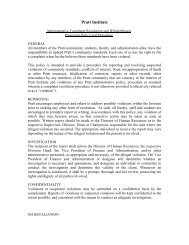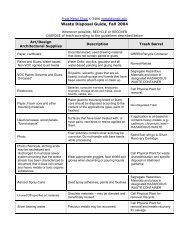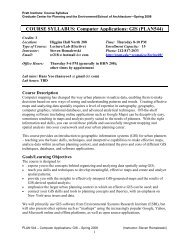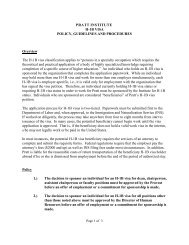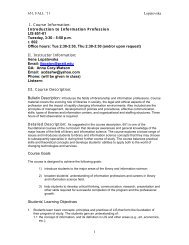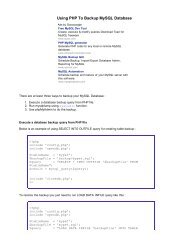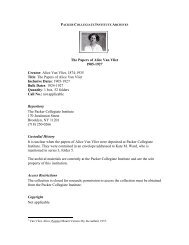Michel Foucault, THE ORDER OF THINGS An Archeology of the ...
Michel Foucault, THE ORDER OF THINGS An Archeology of the ...
Michel Foucault, THE ORDER OF THINGS An Archeology of the ...
You also want an ePaper? Increase the reach of your titles
YUMPU automatically turns print PDFs into web optimized ePapers that Google loves.
<strong>Michel</strong> <strong>Foucault</strong>, <strong>THE</strong> <strong>ORDER</strong> <strong>OF</strong> <strong>THINGS</strong><br />
<strong>An</strong> <strong>Archeology</strong> <strong>of</strong> <strong>the</strong> Human Sciences<br />
A translation <strong>of</strong> Les Mots et les choses (1966)
PART 1<br />
CHAPTER I<br />
Las Meninas<br />
1<br />
The painter is standing a little back from his canvas [1]. He is glancing at his model; perhaps he is considering<br />
whe<strong>the</strong>r to add some finishing touch, though it is also possible that <strong>the</strong> first stroke has not yet been made. The<br />
arm holding <strong>the</strong> brush is bent to <strong>the</strong> left, towards <strong>the</strong> palette; it is motionless, for an instant, between canvas and<br />
paints. The skilled hand is suspended in mid-air, arrested in rapt attention on <strong>the</strong> painter's gaze; and <strong>the</strong> gaze, in<br />
return, waits upon <strong>the</strong> arrested gesture. Between <strong>the</strong> fine point <strong>of</strong> <strong>the</strong> brush and <strong>the</strong> steely gaze, <strong>the</strong> scene is about<br />
to yield up its volume.<br />
But not without a subtle system <strong>of</strong> feints. By standing back a little, <strong>the</strong> painter has placed himself to one side <strong>of</strong><br />
<strong>the</strong> painting on which he is working. That is, for <strong>the</strong> spectator'at present observing him he is to <strong>the</strong> right <strong>of</strong> his<br />
canvas, while <strong>the</strong> latter, <strong>the</strong> canvas, takes up <strong>the</strong> whole <strong>of</strong> <strong>the</strong> extreme left. <strong>An</strong>d <strong>the</strong> canvas has its back turned to<br />
that spectator: he can see nothing <strong>of</strong> it but <strong>the</strong> reverse side, toge<strong>the</strong>r with <strong>the</strong> huge frame on which it is stretched.<br />
The painter, on <strong>the</strong> o<strong>the</strong>r hand, is perfectly visible in his full height; or at any rate, he is not masked by <strong>the</strong> tall<br />
canvas which may soon absorb him, when, taking a step towards it again, he returns to his task; he has no doubt<br />
just appeared, at this very instant, before <strong>the</strong> eyes <strong>of</strong> <strong>the</strong> spectator, emerging from what is virtually a sort <strong>of</strong> vast<br />
cage projected backwards by <strong>the</strong> surface he is painting. Now he can be seen, caught in a moment <strong>of</strong> stillness, at<br />
<strong>the</strong> neutral centre <strong>of</strong> this oscillation. His dark torso and bright face are half-way between <strong>the</strong> visible and <strong>the</strong><br />
invisible: emerging from that canvas beyond our view, he moves into our gaze; but when, in a moment, he makes<br />
a step to <strong>the</strong> right, removing himself from our gaze, he will be standing exactly in front <strong>of</strong> <strong>the</strong> canvas he is<br />
painting; he will enter that region where his painting, neglected for an instant, will, for him, become visible once<br />
more, free <strong>of</strong> shadow and<br />
3<br />
THB <strong>ORDER</strong> <strong>OF</strong> <strong>THINGS</strong><br />
free <strong>of</strong> reticence. As though <strong>the</strong> painter could not at <strong>the</strong> same time be seen on <strong>the</strong> picture where he is represented<br />
and also see that upon which he is representing something. He rules at <strong>the</strong> threshold <strong>of</strong> those two incompatible<br />
visibilities.<br />
The painter is looking, his face turned slightly and his head leaning towards one shoulder. He is staring at a point<br />
to which, even though it is invisible, we, <strong>the</strong> spectators, can easily assign an object, since it is we, ourselves, who<br />
are that point: our bodies, our faces, our eyes. The spectacle he is observing is thus doubly invisible: first,<br />
because it is not represented within <strong>the</strong> space <strong>of</strong> <strong>the</strong> painting, and, second, because it is situated precisely in that<br />
blind point, in that essential hiding-place into which our gaze disappears from ourselves at <strong>the</strong> moment <strong>of</strong> our<br />
actual looking. <strong>An</strong>d yet, how could we fail to see that invisibility, <strong>the</strong>re in front <strong>of</strong> our eyes, since it has its own<br />
perceptible equivalent, its sealed-in figure, in <strong>the</strong> painting itself? We could, in effect, guess what it is <strong>the</strong> painter<br />
is looking at if it were possible for us to glance for a moment at <strong>the</strong> canvas he is working on; but all we can see<br />
<strong>of</strong> that canvas is its texture, <strong>the</strong> horizontal and vertical bars <strong>of</strong> <strong>the</strong> stretcher, and <strong>the</strong> obliquely rising foot <strong>of</strong> <strong>the</strong><br />
easel. The tall, monotonous rectangle occupying <strong>the</strong> whole left portion <strong>of</strong> <strong>the</strong> real picture, and representing <strong>the</strong><br />
back <strong>of</strong> <strong>the</strong> canvas within <strong>the</strong> picture, reconstitutes in <strong>the</strong> form <strong>of</strong> a surface <strong>the</strong> invisibility in depth <strong>of</strong> what <strong>the</strong><br />
artist is observing: that space in which we are, and which we are. From <strong>the</strong> eyes <strong>of</strong> <strong>the</strong> painter to what he is<br />
observing <strong>the</strong>re runs a compelling line that we, <strong>the</strong> onlookers, have no power <strong>of</strong> evading: it runs through <strong>the</strong> real<br />
picture and emerges from its surface to join <strong>the</strong> place from which we see <strong>the</strong> painter observing us; this dotted<br />
line reaches out to us ineluctably, and links us to <strong>the</strong> representation <strong>of</strong> <strong>the</strong> picture. In appearance, this locus is a<br />
simple one; a matter <strong>of</strong> pure reciprocity:<br />
we are looking at a picture in which <strong>the</strong> painter is in turn looking out at us. A mere confrontation, eyes catching<br />
one ano<strong>the</strong>r's glance, direct looks superimposing <strong>the</strong>mselves upon one ano<strong>the</strong>r as <strong>the</strong>y cross. <strong>An</strong>d yet this slender<br />
line <strong>of</strong> reciprocal visibility embraces a whole complex network <strong>of</strong> uncertainties, exchanges, and feints. The<br />
painter is turning his eyes towards us only in so far as we happen to occupy <strong>the</strong> same position as his subject. We,
<strong>the</strong> spectators, are an additional factor. Though greeted by that gaze, we are also dismissed by it, replaced by that<br />
which was always <strong>the</strong>re before we were: <strong>the</strong> model itself. But, inversely, <strong>the</strong> painter's gaze, addressed to <strong>the</strong> void<br />
confronting him outside <strong>the</strong> picture, accepts as many models as <strong>the</strong>re are spectators; in this precise but neutral<br />
place, <strong>the</strong> observer 4<br />
LAS MENINAS<br />
and <strong>the</strong> observed take part in a ceaseless exchange. No gaze is stable, or ra<strong>the</strong>r in <strong>the</strong> neutral furrow <strong>of</strong> <strong>the</strong> gaze<br />
piercing at a right angle through <strong>the</strong> canvas, subject and object, <strong>the</strong> spectator and <strong>the</strong> model, reverse <strong>the</strong>ir roles<br />
infinity. <strong>An</strong>d here <strong>the</strong> great canvas with its back to us on <strong>the</strong> extreme left <strong>of</strong> <strong>the</strong> picture exercises its second<br />
function: stubbornly invisible, it prevents <strong>the</strong> relation <strong>of</strong> <strong>the</strong>se gazes from ever being discoverable or definitely<br />
established. The opaque fixity that it establishes on one side renders forever unstable <strong>the</strong> play <strong>of</strong> metamorphoses<br />
established in <strong>the</strong> centre between spectator and model. Because we can see only that reverse side, we do not<br />
know who we are, or what we are doing. Seen or seeing? The painter is observing a place which, from moment<br />
to moment, never ceases to change its content, its form, its face, its identity. But <strong>the</strong> attentive immobility <strong>of</strong> his<br />
eyes refers us back to ano<strong>the</strong>r direction which <strong>the</strong>y have <strong>of</strong>ten followed already, and which soon, <strong>the</strong>re can be no<br />
doubt, <strong>the</strong>y will take again: that <strong>of</strong> <strong>the</strong> motionless canvas upon which is being traced, has already been traced<br />
perhaps, for a long time and forever, a portrait that will never again be erased. So that <strong>the</strong> painter's sovereign<br />
gaze commands a virtual triangle whose outline defines this picture <strong>of</strong> a picture: at <strong>the</strong> top - <strong>the</strong> only visible<br />
corner - <strong>the</strong> painter's eyes; at one <strong>of</strong> <strong>the</strong> base angles, <strong>the</strong> invisible place occupied by <strong>the</strong> model; at <strong>the</strong> o<strong>the</strong>r base<br />
angle, <strong>the</strong> figure probably sketched out on <strong>the</strong> invisible surface <strong>of</strong> <strong>the</strong> canvas.<br />
As soon as <strong>the</strong>y place <strong>the</strong> spectator in <strong>the</strong> field <strong>of</strong> <strong>the</strong>ir gaze, <strong>the</strong> painter's eyes seize hold <strong>of</strong> him, force him to<br />
enter <strong>the</strong> picture, assign him a place at once privileged and inescapable, levy <strong>the</strong>ir luminous and visible tribute<br />
from him, and project it upon <strong>the</strong> inaccessible surface <strong>of</strong> <strong>the</strong> canvas within <strong>the</strong> picture. He sees his invisibility<br />
made visible to <strong>the</strong> painter and transposed into an image forever invisible to himself. A shock that is augmented<br />
and made more inevitable still by a marginal trap. At <strong>the</strong> extreme right, <strong>the</strong> picture is lit by a window represented<br />
in very sharp perspective; so sharp that we can see scarcely more than <strong>the</strong> embrasure; so that <strong>the</strong> flood <strong>of</strong> light<br />
streaming through it ba<strong>the</strong>s at <strong>the</strong> same time, and with equal generosity, two neighboring spaces, overlapping but<br />
irreducible: <strong>the</strong> surface <strong>of</strong> <strong>the</strong> painting, toge<strong>the</strong>r with <strong>the</strong> volume it represents (which is to say, <strong>the</strong> painter's<br />
studio, or <strong>the</strong> salon in which his easel is now set up), and, in front <strong>of</strong> that surface, <strong>the</strong> real volume occupied by<br />
<strong>the</strong> spectator (or again, <strong>the</strong> unreal site <strong>of</strong> <strong>the</strong> model). <strong>An</strong>d as it passes through <strong>the</strong> room from right to left, this<br />
vast flood <strong>of</strong> golden light carries both <strong>the</strong> spectator towards <strong>the</strong> painter and <strong>the</strong> model towards <strong>the</strong> canvas; it is<br />
this light too, which, washing over <strong>the</strong> painter, makes him visible to <strong>the</strong> spectator and<br />
5<br />
<strong>THE</strong> <strong>ORDER</strong> <strong>OF</strong> <strong>THINGS</strong><br />
turns into golden lines, in <strong>the</strong> model's eyes, <strong>the</strong> frame <strong>of</strong> that enigmatic canvas on which his image, once<br />
transported <strong>the</strong>re, is to be imprisoned. This extreme, partial, scarcely indicated window frees a whole flow <strong>of</strong><br />
daylight which serves as <strong>the</strong> common locus <strong>of</strong> <strong>the</strong> representation. It balances <strong>the</strong> invisible canvas on <strong>the</strong> o<strong>the</strong>r<br />
side <strong>of</strong> <strong>the</strong> picture: just as that canvas, by turning its back to <strong>the</strong> spectators, folds itself in against <strong>the</strong> picture<br />
representing it, and forms, by <strong>the</strong> superimposition <strong>of</strong> its reverse and visible side upon <strong>the</strong> surface <strong>of</strong> <strong>the</strong> picture<br />
depicting it, <strong>the</strong> ground, inaccessible to us, on which <strong>the</strong>re shimmers <strong>the</strong> Image par excellence, so does <strong>the</strong><br />
window, a pure aperture, establish a space as manifest as <strong>the</strong> o<strong>the</strong>r is hidden; as much <strong>the</strong> common ground <strong>of</strong><br />
painter, figures, models, and spectators, as <strong>the</strong> o<strong>the</strong>r is solitary (for no one is looking at it, not even <strong>the</strong> painter).<br />
From <strong>the</strong> right, <strong>the</strong>re streams in through an invisible window <strong>the</strong> pure volume <strong>of</strong> a light that renders all<br />
representation visible; to <strong>the</strong> left extends <strong>the</strong> surface that conceals, on <strong>the</strong> o<strong>the</strong>r side <strong>of</strong> its all too visible woven<br />
texture, <strong>the</strong> representation it bears. The light, by flooding <strong>the</strong> scene (I mean <strong>the</strong> room as well as <strong>the</strong> canvas, <strong>the</strong><br />
room represented on <strong>the</strong> canvas, and <strong>the</strong> room in which <strong>the</strong> canvas stands), envelops <strong>the</strong> figures and <strong>the</strong><br />
spectators and carries <strong>the</strong>m with it, under <strong>the</strong> painter's gaze, towards <strong>the</strong> place where his brush will represent<br />
<strong>the</strong>m. But that place is concealed from us. We are observing ourselves being observed by <strong>the</strong> painter, and made<br />
visible to his eyes by <strong>the</strong> same light that enables us to see him. <strong>An</strong>d just as we are about to apprehend ourselves,<br />
transcribed by his hand as though in a mirror, we find that we can in fact apprehend nothing <strong>of</strong> that mirror but its<br />
lustreless back. The o<strong>the</strong>r side <strong>of</strong> a psyche.
Now, as it happens, exactly opposite <strong>the</strong> spectators - ourselves - on <strong>the</strong> wall forming <strong>the</strong> far end <strong>of</strong> <strong>the</strong> room,<br />
Velazquez has represented a series <strong>of</strong> pictures; and we see that among all those hanging canvases <strong>the</strong>re is one<br />
that shines with particular brightness. Its frame is wider and darker than those <strong>of</strong> <strong>the</strong> o<strong>the</strong>rs; yet <strong>the</strong>re is a fine<br />
white line around its inner edge diffusing over its whole surface a light whose source is not easy to determine;<br />
for it comes from nowhere, unless it be from a space within itself. In this strange light, two silhouettes are<br />
apparent, while above <strong>the</strong>m, and a little behind <strong>the</strong>m, is a heavy purple curtain. The o<strong>the</strong>r pictures reveal little<br />
more than a few paler patches buried in a darkness without depth. This particular one, on <strong>the</strong> o<strong>the</strong>r hand, opens<br />
onto a perspective <strong>of</strong> space in which recognizable forms recede from us in a light that belongs only to itself.<br />
Among all <strong>the</strong>se elements intended to provide representations, while impeding <strong>the</strong>m, hiding <strong>the</strong>m, concealing<br />
<strong>the</strong>m because <strong>of</strong> <strong>the</strong>ir<br />
6<br />
LAS MENINAS<br />
position or <strong>the</strong>ir distance from us, this is <strong>the</strong> only one that fulfils its function in all honesty and enables us to see<br />
what it is supposed to show. Despite its distance from us, despite <strong>the</strong> shadows all around it. But it isn't a picture:<br />
it is a mirror. It <strong>of</strong>fers us at last that enchantment <strong>of</strong> <strong>the</strong> double that until now has been denied us, not only by <strong>the</strong><br />
distant paintings but also by <strong>the</strong> light in <strong>the</strong> foreground with its ironic canvas.<br />
Of all <strong>the</strong> representations represented in <strong>the</strong> picture this is <strong>the</strong> only one visible; but no one is looking at it.<br />
Upright beside his canvas, his attention entirely taken up by his model, <strong>the</strong> painter is unable to see this lookingglass<br />
shining so s<strong>of</strong>tly behind him. The o<strong>the</strong>r figures in <strong>the</strong> picture are also, for <strong>the</strong> most part, turned to face what<br />
must be taking place in front -towards <strong>the</strong> bright invisibility bordering <strong>the</strong> canvas, towards that balcony <strong>of</strong> light<br />
where <strong>the</strong>ir eyes can gaze at those who are gazing back at <strong>the</strong>m, and not towards that dark recess which marks<br />
<strong>the</strong> far end <strong>of</strong> <strong>the</strong> room in which <strong>the</strong>y are represented. There are, it is true, some heads turned away from us in<br />
pr<strong>of</strong>ile: but not one <strong>of</strong> <strong>the</strong>m is turned far enough to see, at <strong>the</strong> back <strong>of</strong> <strong>the</strong> room, that solitary mirror, that tiny<br />
glowing rectangle which is nothing o<strong>the</strong>r than visibility, yet without any gaze able to grasp it, to render it actual,<br />
and to enjoy <strong>the</strong> suddenly ripe fruit <strong>of</strong> <strong>the</strong> spectacle it <strong>of</strong>fers.<br />
It must be admitted that this indifference is equalled only by <strong>the</strong> mirror's own. It is reflecting nothing, in fact, <strong>of</strong><br />
all that is <strong>the</strong>re in <strong>the</strong> same space as itself: nei<strong>the</strong>r <strong>the</strong> painter with his back to it, nor <strong>the</strong> figures in <strong>the</strong> centre <strong>of</strong><br />
<strong>the</strong> room. It is not <strong>the</strong> visible it reflects, in those bright depths. In Dutch painting it was traditional for mirrors to<br />
play a duplicating role:<br />
<strong>the</strong>y repeated <strong>the</strong> original contents <strong>of</strong> <strong>the</strong> picture, only inside an unreal, modified, contracted, concave space.<br />
One saw in <strong>the</strong>m <strong>the</strong> same things as one saw in <strong>the</strong> first instance in <strong>the</strong> painting, but decomposed and recomposed<br />
according to a different law. Here, <strong>the</strong> mirror is saying nothing that has already been said before. Yet<br />
its position is more or less completely central: its upper edge is exactly on an imaginary line running half-way<br />
between <strong>the</strong> top and <strong>the</strong> bottom <strong>of</strong> <strong>the</strong> painting, it hangs right in <strong>the</strong> middle <strong>of</strong> <strong>the</strong> far wall (or at least in <strong>the</strong><br />
middle <strong>of</strong> <strong>the</strong> portion we can see); it ought, <strong>the</strong>refore, to be governed by <strong>the</strong> same lines <strong>of</strong> perspective as <strong>the</strong><br />
picture itself; we might well expect <strong>the</strong> same studio, <strong>the</strong> same painter, <strong>the</strong> same canvas to be arranged within it<br />
according to an identical space;<br />
it could be <strong>the</strong> perfect duplication.<br />
In fact, it shows us nothing <strong>of</strong> what is represented in <strong>the</strong> picture itself. Its motionless gaze extends out in front <strong>of</strong><br />
<strong>the</strong> picture, into that necessarily<br />
7<br />
THB <strong>ORDER</strong> <strong>OF</strong> <strong>THINGS</strong><br />
invisible region which forms its exterior face, to apprehend <strong>the</strong> figures arranged in that space. Instead <strong>of</strong><br />
surrounding visible objects, this mirror cuts straight through <strong>the</strong> whole field <strong>of</strong> <strong>the</strong> representation, ignoring all it<br />
might apprehend within that field, and restores visibility to that which resides outside all view. But <strong>the</strong><br />
invisibility that it overcomes in this way is not <strong>the</strong> invisibility <strong>of</strong> what is hidden: it does not make its way around<br />
any obstacle, it is not distorting any perspective, it is addressing itself to what is invisible both because <strong>of</strong> <strong>the</strong><br />
picture's structure and because <strong>of</strong> its existence as painting. What it is reflecting is that which all <strong>the</strong> figures
within <strong>the</strong> painting are looking at so fixedly, or at least those who are looking straight ahead; it is <strong>the</strong>refore what<br />
<strong>the</strong> spectator would be able to see if <strong>the</strong> painting extended fur<strong>the</strong>r forward, if its bottom edge were brought lower<br />
until it included <strong>the</strong> figures <strong>the</strong> painter is using as models. But it is also, since <strong>the</strong> picture does stop <strong>the</strong>re,<br />
displaying only <strong>the</strong> painter and his studio, what is exterior to <strong>the</strong> picture, in so far as it is a picture - in o<strong>the</strong>r<br />
words, a rectangular fragment <strong>of</strong> lines and colours intended to represent something to <strong>the</strong> eyes <strong>of</strong> any possible<br />
spectator. At <strong>the</strong> far end <strong>of</strong> <strong>the</strong> room, ignored by all, <strong>the</strong> unexpected mirror holds in its glow <strong>the</strong> figures that <strong>the</strong><br />
painter is looking at (<strong>the</strong> painter in his represented, objective reality, <strong>the</strong> reality <strong>of</strong> <strong>the</strong> painter at his work); but<br />
also <strong>the</strong> figures that are looking at <strong>the</strong> painter (in that material reality which <strong>the</strong> lines and <strong>the</strong> colours have laid<br />
out upon <strong>the</strong> canvas). These two groups <strong>of</strong> figures are both equally inaccessible, but in different ways: <strong>the</strong> first<br />
because <strong>of</strong> an effect <strong>of</strong> composition peculiar to <strong>the</strong> painting; <strong>the</strong> second because <strong>of</strong> <strong>the</strong> law that presides over <strong>the</strong><br />
very existence <strong>of</strong> all pictures in general. Here, <strong>the</strong> action <strong>of</strong> representation consists in bringing one <strong>of</strong> <strong>the</strong>se two<br />
forms <strong>of</strong> invisibility into <strong>the</strong> place <strong>of</strong> <strong>the</strong> o<strong>the</strong>r, in an unstable superimposition - and in rendering <strong>the</strong>m both, at<br />
<strong>the</strong> same moment, at <strong>the</strong> o<strong>the</strong>r extremity <strong>of</strong> <strong>the</strong> picture - at that pole which is <strong>the</strong> very height <strong>of</strong> its<br />
representation: that <strong>of</strong> a reflected depth in <strong>the</strong> far recess <strong>of</strong> <strong>the</strong> painting's depth. The mirror provides a meta<strong>the</strong>sis<br />
<strong>of</strong> visibility that affects both <strong>the</strong> space represented in <strong>the</strong> picture and its nature as representation;<br />
it allows us to see, in <strong>the</strong> centre <strong>of</strong> <strong>the</strong> canvas, what in <strong>the</strong> painting is <strong>of</strong> necessity doubly invisible.<br />
A strangely literal, though inverted, application <strong>of</strong> <strong>the</strong> advice given, so it is said, to his pupil by <strong>the</strong> old Pachero<br />
when <strong>the</strong> former was working in his studio in Seville: 'The image should stand out from <strong>the</strong> frame.'<br />
8<br />
LAS MENINAS II<br />
But perhaps it is time to give a name at last to that image which appears in <strong>the</strong> depths <strong>of</strong> <strong>the</strong> mirror, and which<br />
<strong>the</strong> painter is contemplating in front <strong>of</strong> <strong>the</strong> picture. Perhaps it would be better, once and for all, to determine <strong>the</strong><br />
identities <strong>of</strong> all <strong>the</strong> figures presented or indicated here, so as to avoid embroiling ourselves forever in those<br />
vague, ra<strong>the</strong>r abstract designations, so constantly prone to misunderstanding and duplication, '<strong>the</strong> painter', '<strong>the</strong><br />
characters', '<strong>the</strong> models', '<strong>the</strong> spectators', '<strong>the</strong> images'. Ra<strong>the</strong>r than pursue to infinity a language inevitably<br />
inadequate to <strong>the</strong> visible fact, it would be better to say that Velazquez composed a picture; that in this picture he<br />
represented himself, in his studio or in a room <strong>of</strong> <strong>the</strong> Escurial, in <strong>the</strong> act <strong>of</strong> painting two figures whom <strong>the</strong><br />
Infanta Margarita has come <strong>the</strong>re to watch, toge<strong>the</strong>r with an entourage <strong>of</strong> duennas, maids <strong>of</strong> honour, courtiers,<br />
and dwarfs; that we can attribute names to this group <strong>of</strong> people with great precision: tradition recognizes that<br />
here we have Dona Maria Agustina Sarmiente, over <strong>the</strong>re Nieto, in <strong>the</strong> foreground Nicolaso Pertusato, an Italian<br />
jester. We could <strong>the</strong>n add that <strong>the</strong> two personages serving as models to <strong>the</strong> painter are not visible, at least<br />
directly; but that we can see <strong>the</strong>m in a mirror; and that <strong>the</strong>y are, without any doubt, King Philip IV and his wife,<br />
Mariana.<br />
These proper names would form useful landmarks and avoid ambiguous designations; <strong>the</strong>y would tell us in any<br />
case what <strong>the</strong> painter is looking at, and <strong>the</strong> majority <strong>of</strong> <strong>the</strong> characters in <strong>the</strong> picture along with him. But <strong>the</strong><br />
relation <strong>of</strong> language to painting is an infinite relation. It is not that words are imperfect, or that, when confronted<br />
by <strong>the</strong> visible, <strong>the</strong>y prove insuperably inadequate. Nei<strong>the</strong>r can be reduced to <strong>the</strong> o<strong>the</strong>r's terms: it is in vain that<br />
we say what we see; what we see never resides in what we say. <strong>An</strong>d it is in vain that we attempt to show, by <strong>the</strong><br />
use <strong>of</strong> images, metaphors, or similes, what we are saying; <strong>the</strong> space where <strong>the</strong>y achieve <strong>the</strong>ir splendour is not<br />
that deployed by our eyes but that defined by <strong>the</strong> sequential elements <strong>of</strong> syntax. <strong>An</strong>d <strong>the</strong> proper name, in this<br />
particular context, is merely an artifice: it gives us a finger to point with, in o<strong>the</strong>r words, to pass surreptitiously<br />
from <strong>the</strong> space where one speaks to <strong>the</strong> space where one looks; in o<strong>the</strong>r words, to fold one over <strong>the</strong> o<strong>the</strong>r as<br />
though <strong>the</strong>y were equivalents. But if one wishes to keep <strong>the</strong> relation <strong>of</strong> language to vision open, if one wishes to<br />
treat <strong>the</strong>ir incompatibility as a starting-point for speech instead <strong>of</strong> as an obstacle to be avoided, so as to stay as<br />
close as possible to both, <strong>the</strong>n one must erase those proper names<br />
9<br />
<strong>THE</strong> OKDBR <strong>OF</strong> <strong>THINGS</strong><br />
and preserve <strong>the</strong> infinity <strong>of</strong> <strong>the</strong> task. It is perhaps through <strong>the</strong> medium <strong>of</strong> this grey, anonymous language, always<br />
over-meticulous and repetitive because too broad, that <strong>the</strong> painting may, little by little, release its illuminations.
We must <strong>the</strong>refore pretend not to know who is to be reflected in <strong>the</strong> depths <strong>of</strong> that mirror, and interrogate that<br />
reflection in its own terms.<br />
First, it is <strong>the</strong> reverse <strong>of</strong> <strong>the</strong> great canvas represented on <strong>the</strong> left. The reverse, or ra<strong>the</strong>r <strong>the</strong> right side, since it<br />
displays in full face what <strong>the</strong> canvas, by its position, is hiding from us. Fur<strong>the</strong>rmore, it is both in opposition to<br />
<strong>the</strong> window and a reinforcement <strong>of</strong> it. Like <strong>the</strong> window, it provides a ground which is common to <strong>the</strong> painting<br />
and to what lies outside it. But <strong>the</strong> window operates by <strong>the</strong> continuous movement <strong>of</strong> an effusion which, flowing<br />
from right to left, unites <strong>the</strong> attentive figures, <strong>the</strong> painter, and <strong>the</strong> canvas, with <strong>the</strong> spectacle <strong>the</strong>y are observing;<br />
whereas <strong>the</strong> mirror, on <strong>the</strong> o<strong>the</strong>r hand, by means <strong>of</strong> a violent, instantaneous movement, a movement <strong>of</strong> pure<br />
surprise, leaps out from <strong>the</strong> picture in order to reach that which is observed yet invisible in front <strong>of</strong> it, and <strong>the</strong>n,<br />
at <strong>the</strong> far end <strong>of</strong> its fictitious depth, to render it visible yet indifferent to every gaze. The compelling tracer line,<br />
joining <strong>the</strong> reflection to that which it is reflecting, cuts perpendicularly through <strong>the</strong> lateral flood <strong>of</strong> light. Lastly<br />
-and this is <strong>the</strong> mirror's third function - it stands adjacent to a doorway which forms an opening, like <strong>the</strong> mirror<br />
itself, in <strong>the</strong> far wall <strong>of</strong> <strong>the</strong> room. This doorway too forms a bright and sharply defined rectangle whose s<strong>of</strong>t light<br />
does not shine through into <strong>the</strong> room. It would be nothing but a gilded panel if it were not recessed out from <strong>the</strong><br />
room by means <strong>of</strong> one leaf <strong>of</strong> a carved door, <strong>the</strong> curve <strong>of</strong> a curtain, and <strong>the</strong> shadows <strong>of</strong> several steps. Beyond <strong>the</strong><br />
steps, a corridor begins; but instead <strong>of</strong> losing itself in obscurity, it is dissipated in a yellow dazzle where <strong>the</strong><br />
light, without coming in, whirls around on itself in dynamic repose. Against this background, at once near and<br />
limitless, a man stands out in full-length silhouette; he is seen in pr<strong>of</strong>ile; with one hand he is holding back <strong>the</strong><br />
weight <strong>of</strong> a curtain; his feet are placed on different steps; one knee is bent. He may be about to enter <strong>the</strong> room; or<br />
he may be merely observing what is going on inside it, content to surprise those within without being seen himself.<br />
Like <strong>the</strong> mirror, his eyes are directed towards <strong>the</strong> o<strong>the</strong>r side <strong>of</strong> <strong>the</strong> scene; nor is anyone paying any more<br />
attention to him than to <strong>the</strong> mirror. We do not know where he has come from: it could be that by following<br />
uncertain corridors he has just made his way around <strong>the</strong> outside <strong>of</strong> <strong>the</strong> room in which <strong>the</strong>se characters are<br />
collected and <strong>the</strong> painter is at work;<br />
10<br />
LAS MENINAS<br />
perhaps he too, a short while ago, was <strong>the</strong>re in <strong>the</strong> forefront <strong>of</strong> <strong>the</strong> scene, in <strong>the</strong> invisible region still being<br />
contemplated by all those eyes in <strong>the</strong> picture. Like <strong>the</strong> images perceived in <strong>the</strong> looking-glass, it is possible that<br />
he too is an emissary from that evident yet hidden space. Even so, <strong>the</strong>re is a difference: he is <strong>the</strong>re in flesh and<br />
blood; he has appeared from <strong>the</strong> outside, on <strong>the</strong> threshold <strong>of</strong> <strong>the</strong> area represented; he is indubitable - not a<br />
probable reflection but an irruption. The mirror, by making visible, beyond even <strong>the</strong> walls <strong>of</strong> <strong>the</strong> studio itself,<br />
what is happening in front <strong>of</strong> <strong>the</strong> picture, creates, in its sagittal dimension, an oscillation between <strong>the</strong> interior and<br />
<strong>the</strong> exterior. One foot only on <strong>the</strong> lower step, his body entirely in pr<strong>of</strong>ile, <strong>the</strong> ambiguous visitor is coming in and<br />
going out at <strong>the</strong> same time, like a pendulum caught at <strong>the</strong> bottom <strong>of</strong> its swing. He repeats on <strong>the</strong> spot, but in <strong>the</strong><br />
dark reality <strong>of</strong> his body, <strong>the</strong> instantaneous movement <strong>of</strong> those images flashing across <strong>the</strong> room, plunging into <strong>the</strong><br />
mirror, being reflected <strong>the</strong>re, and springing out from it again like visible, new, and identical species. Pale,<br />
minuscule, those silhouetted figures in <strong>the</strong> mirror are challenged by <strong>the</strong> tall, solid stature <strong>of</strong> <strong>the</strong> man appearing in<br />
<strong>the</strong> doorway. But we must move down again from <strong>the</strong> back <strong>of</strong> <strong>the</strong> picture towards <strong>the</strong> front <strong>of</strong> <strong>the</strong> stage; we must<br />
leave that periphery whose volute we have just been following. Starting from <strong>the</strong> painter's gaze, which<br />
constitutes an <strong>of</strong>f-centre centre to <strong>the</strong> left, we perceive first <strong>of</strong> all <strong>the</strong> back <strong>of</strong> <strong>the</strong> canvas, <strong>the</strong>n <strong>the</strong> paintings hung<br />
on <strong>the</strong> wall, with <strong>the</strong> mirror in <strong>the</strong>ir centre, <strong>the</strong>n <strong>the</strong> open doorway, <strong>the</strong>n more pictures, <strong>of</strong> which, because <strong>of</strong> <strong>the</strong><br />
sharpness <strong>of</strong> <strong>the</strong> perspective, we can see no more than <strong>the</strong> edges <strong>of</strong> <strong>the</strong> frames, and finally, at <strong>the</strong> extreme right,<br />
<strong>the</strong> window, or ra<strong>the</strong>r <strong>the</strong> groove in <strong>the</strong> wall from which <strong>the</strong> light is pouring. This spiral shell presents us with <strong>the</strong><br />
entire cycle <strong>of</strong> representation: <strong>the</strong> gaze, <strong>the</strong> palette and brush, <strong>the</strong> canvas innocent <strong>of</strong> signs (<strong>the</strong>se are <strong>the</strong> material<br />
tools <strong>of</strong> representation), <strong>the</strong> paintings, <strong>the</strong> reflections, <strong>the</strong> real man (<strong>the</strong> completed representation, but as it were<br />
freed from its illusory or truthful contents, which are juxtaposed to it); <strong>the</strong>n <strong>the</strong> representation dissolves again:<br />
we can see only <strong>the</strong> frames, and <strong>the</strong> light that is flooding <strong>the</strong> pictures from outside, but that <strong>the</strong>y, in return, must<br />
reconstitute in <strong>the</strong>ir own kind, as though it were coming from elsewhere, passing through <strong>the</strong>ir dark wooden<br />
frames. <strong>An</strong>d we do, in fact, see this light on <strong>the</strong> painting, apparently welling out from <strong>the</strong> crack <strong>of</strong> <strong>the</strong> frame; and<br />
from <strong>the</strong>re it moves over to touch <strong>the</strong> brow, <strong>the</strong> cheekbones, <strong>the</strong> eyes, <strong>the</strong> gaze <strong>of</strong> <strong>the</strong> painter, who is holding a<br />
palette in one hand and in <strong>the</strong> o<strong>the</strong>r a fine brush . . . <strong>An</strong>d so <strong>the</strong> spiral is closed, or ra<strong>the</strong>r, by means <strong>of</strong> that light,
is opened.<br />
11<br />
<strong>THE</strong> <strong>ORDER</strong> <strong>OF</strong> <strong>THINGS</strong><br />
This opening is not, like <strong>the</strong> one in <strong>the</strong> back wall, made by pulling back a door; it is <strong>the</strong> whole breadth <strong>of</strong> <strong>the</strong><br />
picture itself, and <strong>the</strong> looks that pass across it are not those <strong>of</strong> a distant visitor. The frieze that occupies <strong>the</strong><br />
foreground and <strong>the</strong> middle ground <strong>of</strong> <strong>the</strong> picture represents - if we include <strong>the</strong> painter - eight characters. Five <strong>of</strong><br />
<strong>the</strong>se, <strong>the</strong>ir heads more or less bent, turned or inclined, are looking straight out at right angles to <strong>the</strong> surface <strong>of</strong><br />
<strong>the</strong> picture. The centre <strong>of</strong> <strong>the</strong> group is occupied by <strong>the</strong> little Infanta, with her flared pink and gray dress. The<br />
princess is turning her head towards <strong>the</strong> right side <strong>of</strong> <strong>the</strong> picture, while her torso and <strong>the</strong> big panniers o<strong>the</strong>r dress<br />
slant away slightly towards <strong>the</strong> left; but her gaze is directed absolutely straight towards <strong>the</strong> spectator standing in<br />
front <strong>of</strong> <strong>the</strong> painting. A vertical line dividing <strong>the</strong> canvas into two equal halves would pass between <strong>the</strong> child's<br />
eyes. Her face is a third <strong>of</strong> <strong>the</strong> total height <strong>of</strong> <strong>the</strong> picture above <strong>the</strong> lower frame. So that here, beyond all<br />
question, resides <strong>the</strong> principal <strong>the</strong>me <strong>of</strong> <strong>the</strong> composition; this is <strong>the</strong> very object <strong>of</strong> this painting. As though to<br />
prove this and to emphasize it even more, Velazquez has made use <strong>of</strong> a traditional visual device: beside <strong>the</strong><br />
principal figure he has placed a secondary one, kneeling and looking in towards <strong>the</strong> central one. Like a donor in<br />
prayer, like an angel greeting <strong>the</strong> Virgin, a maid <strong>of</strong> honour on her knees is stretching out her hands towards <strong>the</strong><br />
princess. Her face stands out in perfect pr<strong>of</strong>ile against <strong>the</strong> background. It is at <strong>the</strong> same height as that <strong>of</strong> <strong>the</strong><br />
child. This attendant is looking at <strong>the</strong> princess and only at <strong>the</strong> princess. A little to <strong>the</strong> right, <strong>the</strong>re stands ano<strong>the</strong>r<br />
maid <strong>of</strong> honour, also turned towards <strong>the</strong> Infanta, leaning slightly over her, but with her eyes clearly directed<br />
towards <strong>the</strong> front, towards <strong>the</strong> same spot already being gazed at by <strong>the</strong> painter and <strong>the</strong> princess. Lastly, two o<strong>the</strong>r<br />
groups made up <strong>of</strong> two figures each: one <strong>of</strong> <strong>the</strong>se groups is fur<strong>the</strong>r away; <strong>the</strong> o<strong>the</strong>r, made up <strong>of</strong> <strong>the</strong> two dwarfs, is<br />
right in <strong>the</strong> foreground. One character in each <strong>of</strong> <strong>the</strong>se pairs is looking straight out, <strong>the</strong> o<strong>the</strong>r to <strong>the</strong> left or <strong>the</strong><br />
right. Because <strong>of</strong> <strong>the</strong>ir positions and <strong>the</strong>ir size, <strong>the</strong>se two groups correspond and <strong>the</strong>mselves form a pair: behind,<br />
<strong>the</strong> courtiers (<strong>the</strong> woman, to <strong>the</strong> left, looks to <strong>the</strong> right); in front, <strong>the</strong> dwarfs (<strong>the</strong> boy, who is at <strong>the</strong> extreme right,<br />
looks in towards <strong>the</strong> centre <strong>of</strong> <strong>the</strong> picture). This group <strong>of</strong> characters, arranged in this manner, can be taken to<br />
constitute, according to <strong>the</strong> way one looks at <strong>the</strong> picture and <strong>the</strong> centre <strong>of</strong> reference chosen, two different figures.<br />
The first would be a large X: <strong>the</strong> top left-hand point <strong>of</strong> this X would be <strong>the</strong> painter's eyes; <strong>the</strong> top right-hand one,<br />
<strong>the</strong> male courtier's eyes; at <strong>the</strong> bottom left-hand comer <strong>the</strong>re is <strong>the</strong> comer <strong>of</strong> <strong>the</strong> canvas represented with its back<br />
towards us (or,<br />
12<br />
LAS MBNINAS<br />
more exactly, <strong>the</strong> foot <strong>of</strong> <strong>the</strong> easel); at <strong>the</strong> bottom right-hand corner, <strong>the</strong> dwarf (his foot on <strong>the</strong> dog's back).<br />
Where <strong>the</strong>se two lines intersect, at <strong>the</strong> centre <strong>of</strong> <strong>the</strong> X, are <strong>the</strong> eyes <strong>of</strong> <strong>the</strong> Infanta. The second figure would be<br />
more that <strong>of</strong> a vast curve, its two ends determined by <strong>the</strong> painter on <strong>the</strong> left and <strong>the</strong> male courtier on <strong>the</strong> right -<br />
both <strong>the</strong>se extremities occurring high up in <strong>the</strong> picture and set back from its surface; <strong>the</strong> centre <strong>of</strong> <strong>the</strong> curve,<br />
much nearer to us, would coincide with <strong>the</strong> princess's face and <strong>the</strong> look her maid <strong>of</strong> honour is directing towards<br />
her. This curve describes a shallow hollow across <strong>the</strong> centre <strong>of</strong> <strong>the</strong> picture which at once contains and sets <strong>of</strong>f <strong>the</strong><br />
position <strong>of</strong> <strong>the</strong> mirror at <strong>the</strong> back.<br />
There are thus two centres around which <strong>the</strong> picture may be organized, according to whe<strong>the</strong>r <strong>the</strong> fluttering<br />
attention <strong>of</strong> <strong>the</strong> spectator decides to settle in this place or in that. The princess is standing upright in <strong>the</strong> centre <strong>of</strong><br />
a St <strong>An</strong>drew's cross, which is revolving around her with its eddies <strong>of</strong> courtiers, maids <strong>of</strong> honour, animals, and<br />
fools. But this pivoting movement is frozen. Frozen by a spectacle that would be absolutely invisible if those<br />
same characters, suddenly motionless, were not <strong>of</strong>fering us, as though in <strong>the</strong> hollow <strong>of</strong> a goblet, <strong>the</strong> possibility <strong>of</strong><br />
seeing in <strong>the</strong> depths <strong>of</strong> a mirror <strong>the</strong> unforeseen double <strong>of</strong> what <strong>the</strong>y are observing. In depth, it is <strong>the</strong> princess who<br />
is superimposed on <strong>the</strong> mirror; vertically, it is <strong>the</strong> reflection that is superimposed on <strong>the</strong> face. But, because <strong>of</strong> <strong>the</strong><br />
perspective, <strong>the</strong>y are very close to one ano<strong>the</strong>r. Moreover, from each <strong>of</strong> <strong>the</strong>m <strong>the</strong>re springs an ineluctable line:<br />
<strong>the</strong> line issuing from <strong>the</strong> mirror crosses <strong>the</strong> whole <strong>of</strong> <strong>the</strong> depth represented (and even more, since <strong>the</strong> mirror<br />
forms a hole in <strong>the</strong> back wall and brings a fur<strong>the</strong>r space into being behind it);<br />
<strong>the</strong> o<strong>the</strong>r line is shorter: it comes from <strong>the</strong> child's eyes and crosses only <strong>the</strong> foreground. These two sagittal lines
converge at a very sharp angle, and <strong>the</strong> point where <strong>the</strong>y meet, springing out from <strong>the</strong> painted surface, occurs in<br />
front <strong>of</strong> <strong>the</strong> picture, more or less exactly at <strong>the</strong> spot from which we are observing it. It is an uncertain point<br />
because we cannot see it; yet it is an inevitable and perfectly defined point too, since it is determined by those<br />
two dominating figures and confirmed fur<strong>the</strong>r by o<strong>the</strong>r, adjacent dotted lines which also have <strong>the</strong>ir origin inside<br />
<strong>the</strong> picture and emerge from it in a similar fashion.<br />
What is <strong>the</strong>re, <strong>the</strong>n, we ask at last, in that place which is completely inaccessible because it is exterior to <strong>the</strong><br />
picture, yet is prescribed by all <strong>the</strong> lines <strong>of</strong> its composition? What is <strong>the</strong> spectacle, what are <strong>the</strong> faces that are<br />
reflected first <strong>of</strong> all in <strong>the</strong> depths <strong>of</strong> <strong>the</strong> Infanta's eyes, <strong>the</strong>n in <strong>the</strong> courtiers' and <strong>the</strong> painter's, and finally in <strong>the</strong><br />
distant glow <strong>of</strong> <strong>the</strong> mirror? But <strong>the</strong> i3<br />
<strong>THE</strong> <strong>ORDER</strong> <strong>OF</strong> <strong>THINGS</strong><br />
question immediately becomes a double one: <strong>the</strong> face reflected in <strong>the</strong> mirror is also <strong>the</strong> face that is contemplating<br />
it; what all <strong>the</strong> figures in <strong>the</strong> picture are looking at are <strong>the</strong> two figures to whose eyes <strong>the</strong>y too present a scene to<br />
be observed. The entire picture is looking out at a scene for which it is itself a scene. A condition <strong>of</strong> pure<br />
reciprocity manifested by <strong>the</strong> observing and observed mirror, <strong>the</strong> two stages <strong>of</strong> which are uncoupled at <strong>the</strong> two<br />
lower corners <strong>of</strong> <strong>the</strong> picture: on <strong>the</strong> left <strong>the</strong> canvas with its back to us, by means <strong>of</strong> which <strong>the</strong> exterior point is<br />
made into pure spectacle;<br />
to <strong>the</strong> right <strong>the</strong> dog lying on <strong>the</strong> floor, <strong>the</strong> only element in <strong>the</strong> picture that is nei<strong>the</strong>r looking at anything nor<br />
moving, because it is not intended, with its deep reliefs and <strong>the</strong> light playing on its silky hair, to be anything but<br />
an object to be seen.<br />
Our first glance at <strong>the</strong> painting told us what it' is' that creates this spectacle-as-observation. It is <strong>the</strong> two<br />
sovereigns. One can sense <strong>the</strong>ir presence already in <strong>the</strong> respectful gaze <strong>of</strong> <strong>the</strong> figures in <strong>the</strong> picture, in <strong>the</strong><br />
astonishment <strong>of</strong> <strong>the</strong> child and <strong>the</strong> dwarfs. We recognize <strong>the</strong>m, at <strong>the</strong> far end <strong>of</strong> <strong>the</strong> picture, in <strong>the</strong> two tiny<br />
silhouettes gleaming out from <strong>the</strong> looking-glass. In <strong>the</strong> midst <strong>of</strong> all those attentive faces, all those richly dressed<br />
bodies, <strong>the</strong>y are <strong>the</strong> palest, <strong>the</strong> most unreal, <strong>the</strong> most compromised <strong>of</strong> all <strong>the</strong> painting's images: a movement, a<br />
little light, would be sufficient to eclipse <strong>the</strong>m. Of all <strong>the</strong>se figures represented before us, <strong>the</strong>y are also <strong>the</strong> most<br />
ignored, since no one is paying <strong>the</strong> slightest attention to that reflection which has slipped into <strong>the</strong> room behind<br />
<strong>the</strong>m all, silently occupying its unsuspected space; in so far as <strong>the</strong>y are visible, <strong>the</strong>y are <strong>the</strong> frailest and <strong>the</strong> most<br />
distant form <strong>of</strong> all reality. Inversely, in so far as <strong>the</strong>y stand outside <strong>the</strong> picture and are <strong>the</strong>refore withdrawn from<br />
it in an essential invisibility, <strong>the</strong>y provide <strong>the</strong> centre around which <strong>the</strong> entire representation is ordered: it is <strong>the</strong>y<br />
who are being faced, it is towards <strong>the</strong>m that everyone is turned, it is to <strong>the</strong>ir eyes that <strong>the</strong> princess is being<br />
presented in her holiday clo<strong>the</strong>s; from <strong>the</strong> canvas with its back to us to <strong>the</strong> Infanta, and from <strong>the</strong> Infanta to <strong>the</strong><br />
dwarf playing on <strong>the</strong> extreme right, <strong>the</strong>re runs a curve (or again, <strong>the</strong> lower fork <strong>of</strong> <strong>the</strong> X opens) that orders <strong>the</strong><br />
whole arrangement <strong>of</strong> <strong>the</strong> picture to <strong>the</strong>ir gaze and thus makes apparent <strong>the</strong> true centre <strong>of</strong> <strong>the</strong> composition, to<br />
which <strong>the</strong> Infanta's gaze and <strong>the</strong> image in <strong>the</strong> mirror are both finally subject.<br />
In <strong>the</strong> realm <strong>of</strong> <strong>the</strong> anecdote, this centre is symbolically sovereign, since it is occupied by King Philip IV and his<br />
wife. But it is so above all because <strong>of</strong> <strong>the</strong> triple function it fulfils in relation to <strong>the</strong> picture. For in it <strong>the</strong>re occurs<br />
an exact superimposition <strong>of</strong> <strong>the</strong> model's gaze as it is being<br />
14<br />
LAS MENINAS<br />
painted, <strong>of</strong> <strong>the</strong> spectator's as he contemplates <strong>the</strong> painting, and <strong>of</strong> <strong>the</strong> painter's as he is composing his picture (not<br />
<strong>the</strong> one represented, but <strong>the</strong> one in front <strong>of</strong> us which we are discussing). These three 'observing' functions come<br />
toge<strong>the</strong>r in a point exterior to <strong>the</strong> picture: that is, an ideal point in relation to what is represented, but a perfectly<br />
real one too, since it is also <strong>the</strong> starting-point that makes <strong>the</strong> representation possible. Within that reality itself, it<br />
cannot not be invisible. <strong>An</strong>d yet, that reality is projected within <strong>the</strong> picture - projected and diffracted in three<br />
forms which correspond to <strong>the</strong> three functions <strong>of</strong> that ideal and real point. They are: on <strong>the</strong> left, <strong>the</strong> painter with<br />
his palette in his hand (a self-portrait <strong>of</strong> Velazquez); to <strong>the</strong> right, <strong>the</strong> visitor, one foot on <strong>the</strong> step, ready to enter<br />
<strong>the</strong> room; he is taking in <strong>the</strong> scene from <strong>the</strong> back, but he can see <strong>the</strong> royal couple, who are <strong>the</strong> spectacle itself,<br />
from <strong>the</strong> front; and lastly, in <strong>the</strong> centre, <strong>the</strong> reflection <strong>of</strong> <strong>the</strong> king and <strong>the</strong> queen, richly dressed, motionless, in <strong>the</strong><br />
attitude <strong>of</strong> patient models.
A reflection that shows us quite simply, and in shadow, what all those in <strong>the</strong> foreground are looking at. It<br />
restores, as if by magic, what is lacking in every gaze: in <strong>the</strong> painter's, <strong>the</strong> model, which his represented double<br />
is duplicating over <strong>the</strong>re in <strong>the</strong> picture; in <strong>the</strong> king's, his portrait, which is being finished <strong>of</strong>f on that slope <strong>of</strong> <strong>the</strong><br />
canvas that he cannot perceive from where he stands; in that <strong>of</strong> <strong>the</strong> spectator, <strong>the</strong> real centre <strong>of</strong> <strong>the</strong> scene, whose<br />
place he himself has taken as though by usurpation. But perhaps this generosity on <strong>the</strong> part <strong>of</strong> <strong>the</strong> mirror is<br />
feigned; perhaps it is hiding as much as and even more than it reveals. That space where <strong>the</strong> king and his wife<br />
hold sway belongs equally well to <strong>the</strong> artist and to <strong>the</strong> spectator:<br />
in <strong>the</strong> depths <strong>of</strong> <strong>the</strong> mirror <strong>the</strong>re could also appear - <strong>the</strong>re ought to appear - <strong>the</strong> anonymous face <strong>of</strong> <strong>the</strong> passer-by<br />
and that <strong>of</strong> Velazquez. For <strong>the</strong> function <strong>of</strong> that reflection is to draw into <strong>the</strong> interior <strong>of</strong> <strong>the</strong> picture what is<br />
intimately foreign to it: <strong>the</strong> gaze which has organized it and <strong>the</strong> gaze for which it is displayed. But because <strong>the</strong>y<br />
are present within <strong>the</strong> picture, to <strong>the</strong> right and to <strong>the</strong> left, <strong>the</strong> artist and <strong>the</strong> visitor cannot be given a place in <strong>the</strong><br />
mirror: just as <strong>the</strong> king appears in <strong>the</strong> depths <strong>of</strong> <strong>the</strong> looking-glass precisely because he does not belong to <strong>the</strong><br />
picture.<br />
In <strong>the</strong> great volute that runs around <strong>the</strong> perimeter <strong>of</strong> <strong>the</strong> studio, from <strong>the</strong> gaze <strong>of</strong> <strong>the</strong> painter, with his motionless<br />
hand and palette, right round to <strong>the</strong> finished paintings, representation came into being, reached completion, only<br />
to dissolve once more into <strong>the</strong> light; <strong>the</strong> cycle was complete. The lines that run through <strong>the</strong> depth <strong>of</strong> <strong>the</strong> picture,<br />
on <strong>the</strong> o<strong>the</strong>r hand, are not complete; <strong>the</strong>y all lack a segment <strong>of</strong> <strong>the</strong>ir trajectories. This gap is<br />
15<br />
<strong>THE</strong> <strong>ORDER</strong> <strong>OF</strong> <strong>THINGS</strong><br />
caused by <strong>the</strong> absence <strong>of</strong> <strong>the</strong> king - an absence that is an artifice on <strong>the</strong> part <strong>of</strong> <strong>the</strong> painter. But this artifice both<br />
conceals and indicates ano<strong>the</strong>r vacancy which is, on <strong>the</strong> contrary, immediate: that <strong>of</strong> <strong>the</strong> painter and <strong>the</strong> spectator<br />
when <strong>the</strong>y are looking at or composing <strong>the</strong> picture. It may be that, in this picture, as in all <strong>the</strong> representations <strong>of</strong><br />
which it is, as it were, <strong>the</strong> manifest essence, <strong>the</strong> pr<strong>of</strong>ound invisibility <strong>of</strong> what one sees is inseparable from <strong>the</strong><br />
invisibility <strong>of</strong> <strong>the</strong> person seeing - despite all mirrors, reflections, imitations, and portraits. Around <strong>the</strong> scene are<br />
arranged all <strong>the</strong> signs and successive forms <strong>of</strong> representation; but <strong>the</strong> double relation <strong>of</strong> <strong>the</strong> representation to its<br />
model and to its sovereign, to its author as well as to <strong>the</strong> person to whom it is being <strong>of</strong>fered, this relation is<br />
necessarily interrupted. It can never be present without some residuum, even in a representation that <strong>of</strong>fers itself<br />
as a spectacle. In <strong>the</strong> depth that traverses <strong>the</strong> picture, hollowing it into a fictitious recess and projecting it<br />
forward in front <strong>of</strong> itself, it is not possible for <strong>the</strong> pure felicity <strong>of</strong> <strong>the</strong> image ever to present in a full light both <strong>the</strong><br />
master who is representing and <strong>the</strong> sovereign who is being represented.<br />
Perhaps <strong>the</strong>re exists, in this painting by Velazquez, <strong>the</strong> representation as it were, <strong>of</strong> Classical representation, and<br />
<strong>the</strong> definition <strong>of</strong> <strong>the</strong> space it opens up to us. <strong>An</strong>d, indeed, representation undertakes to represent itself here in all<br />
its elements, with its images, <strong>the</strong> eyes to which it is <strong>of</strong>fered, <strong>the</strong> faces it makes visible, <strong>the</strong> gestures that call it<br />
into being. But <strong>the</strong>re, in <strong>the</strong> midst <strong>of</strong> this dispersion which it is simultaneously grouping toge<strong>the</strong>r and spreading<br />
out before us, indicated compellingly from every side, is an essential void: <strong>the</strong> necessary disappearance <strong>of</strong> that<br />
which is its foundation - <strong>of</strong> <strong>the</strong> person it resembles and <strong>the</strong> person in whose eyes it is only a resemblance. This<br />
very subject - which is <strong>the</strong> same - has been elided. <strong>An</strong>d representation, freed finally from <strong>the</strong> relation that was<br />
impeding it, can <strong>of</strong>fer itself as representation in its pure form.



